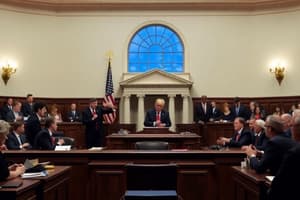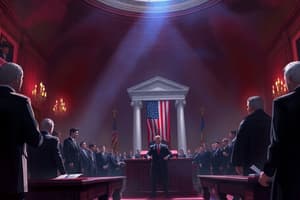Podcast
Questions and Answers
Describe the constitutional process of impeachment.
Describe the constitutional process of impeachment.
The Constitution prescribes impeachment as a political equivalent of an indictment, allowing the House to impeach the president for 'Treason, Bribery, or other high Crimes and Misdemeanors.' The House requires a simple majority vote, and if impeached, the president is tried by the Senate, presided over by the chief justice. A two-thirds Senate vote is needed for conviction and removal.
Outline the procedures established in the Twenty-fifth Amendment regarding presidential succession and disability.
Outline the procedures established in the Twenty-fifth Amendment regarding presidential succession and disability.
The Twenty-fifth Amendment allows the vice president to act as president if the president is disabled or declares so. It also defines the succession order: vice president, Speaker of the House, president pro tempore of the Senate, followed by cabinet in chronological order of department establishment.
Trace the evolution of the presidency.
Trace the evolution of the presidency.
Presidential power has expanded beyond the Constitution's original vision, influenced by America’s global prominence and technological advances. Presidents have actively shaped the role by increasing responsibilities and political resources.
Identify the major offices that serve as key aides and advisors to the president.
Identify the major offices that serve as key aides and advisors to the president.
Explain how the American system of separation of powers functions as one of shared powers.
Explain how the American system of separation of powers functions as one of shared powers.
What methods may presidents use to improve their chances of obtaining party support in Congress?
What methods may presidents use to improve their chances of obtaining party support in Congress?
Summarize the constitutional powers allocated to the president in national security.
Summarize the constitutional powers allocated to the president in national security.
Flashcards are hidden until you start studying
Study Notes
Impeachment Process
- Impeachment acts as a political indictment; a formal accusation rather than conviction.
- The House of Representatives can impeach the president for "Treason, Bribery, or other high Crimes and Misdemeanors" with a simple majority.
- Post-impeachment, the Senate holds a trial presided over by the Chief Justice for presidential trials.
- A two-thirds Senate vote is required for conviction and removal.
Twenty-Fifth Amendment
- Addresses presidential disability by allowing the vice president to act if the president is deemed disabled by the vice president and cabinet or if the president self-declares.
- Outlines the procedure for a recuperated president to reclaim their position.
- Specifies succession order following the president and vice president, including the Speaker of the House, president pro tempore of the Senate, and cabinet members in chronological order of department establishment.
Evolution of the Presidency
- Presidential power now extends beyond constitutional limits, shaped by multiple influences.
- The role evolved alongside America's global prominence and technological advancements.
- Presidents have proactively expanded their roles and responsibilities, altering the political landscape.
Key Presidential Aides and Advisors
- The Vice President's role varies based on the president's delegation.
- The Cabinet consists of 14 secretaries and the Attorney General, with occasional additional designated officials.
- The Executive Office includes prominent policy-making bodies like the National Security Council and the Office of Management and Budget.
- The White House Office houses essential aides like the chief of staff and press secretary.
- First Ladies have become influential advisors in policy-making.
Shared Powers in Separation of Powers
- Presidents have limited unilateral power and share executive, legislative, and judicial authority with other government branches.
- The system operates under checks and balances, ensuring no single branch dominates.
Presidential Party Support in Congress
- To gain congressional support, presidents often aim to increase party representation in the legislature.
- "Presidential coattails" phenomenon displays voters favoring congressional candidates of the president's party as a show of support.
Constitutional Powers in National Security
- Serves as Commander in Chief of the armed forces.
- Holds the authority to make treaties, requiring a two-thirds Senate agreement.
- Nominates ambassadors, needing majority Senate approval.
- Receives foreign ambassadors, granting diplomatic recognition to governments.
Studying That Suits You
Use AI to generate personalized quizzes and flashcards to suit your learning preferences.




